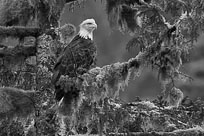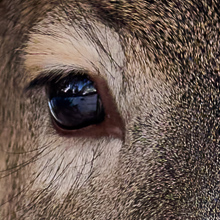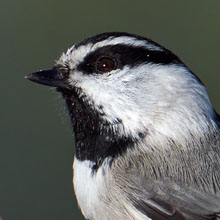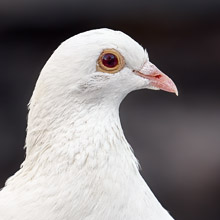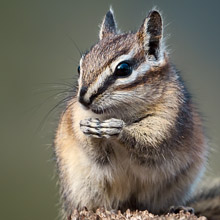Availability: Undetermined - Enquiries?
In the Field
Spring's First Chipper. Findlay Creek, BC, Canada. March 20, 2022.
This is my sixth gallery post detailing my experiences with shooting wildlife using the Nikon Z 9. I traditionally use winter and early spring to test out and learn more about my gear and the bulk of my shooting during this time is opportunistic with local subjects. In the winter of 2021/2022 I spent a tremendous amount of time sussing out how the Nikon Z 9 performs, with a lion's share of that time spent poking and prodding the AF system to get a good handle on its various nuances.
On March 20 of 2022 I spent a few hours pointing my Z 9 at the birds and other critters around our cabin. On this day the first Eastern Pine Chipmunk of the year emerged from hibernation, and when I saw it I thought "Ah hah...another species to test out the Z 9's subject detection on!" Now obviously chipmunks aren't super high on most wildlife photographer's hit list, but because Nikon conservatively states that when using its subject detection system set to Animal it will recognize "dogs and cats and other animals that resemble them" it makes one wonder just HOW similar the animal has to be to a dog or cat for the system to work. Well...so far I haven't found an animal that it DOESN'T work on - so I guess the deer, elk, moose, squirrels, chipmunks, fish (on my TV screen), and cows I have successfully tested the Animal subject detection mode on all "resemble" dogs and cats! ;-)
This shot was captured with a Nikon Z 9 and a lens/TC combination I have absolutely fallen in love with - the Nikkor 500mm f5.6E PF plus TC-14EIII (1.4x) teleconverter. When shooting small birds or mammals (like this chipmunk) at close range with this lens/TC combo its maximum aperture of f8 is anything BUT a problem - to get a DoF sufficient to have all the critical bits in focus you have to stop down anyway (this image was shot at f11).
Here's a larger version (4800 pixel) of this early spring chipper:
• Spring's First Chipper! Download 4800 pixel image (JPEG: 3.0 MB)
ADDITIONAL NOTES:
1. This image - in all resolutions - is protected by copyright. I'm fine with personal uses of them (including use as desktop backgrounds or screensavers on your own computer), but unauthorized commercial use of the image is prohibited by law. Thanks in advance for respecting my copyright!
2. Like all photographs on this website, this image was captured following the strict ethical guidelines described in The Wildlife FIRST! Principles of Photographer Conduct. I encourage all wildlife photographers to always put the welfare of their subjects above the value of their photographs.
Behind the Camera
Spring's First Chipper. Findlay Creek, BC, Canada. March 20, 2022.
Compressed RAW (NEF) 14-bit format; ISO 1100.
Nikon Z 9 paired with Nikkor 500mm f5.6E PF plus TC-14EIII (1.4x) teleconverter (700mm focal length). Supported on Jobu Algonquin tripod with Jobu HD Mk IV gimbal head. VR on in Sport mode. 3D-Tracking area mode with subject detection on Animal mode.
1/500s @ f11; -0.3 stop compensation from matrix-metered exposure setting.
At the Computer
Spring's First Chipper. Findlay Creek, BC, Canada. March 20, 2022.
RAW Conversion to 16-bit PSD file (and JPEG files for web use), including all global and selective adjustments, using Phase One's Capture One Pro 21. Global adjustments on this image were limited to a single levels (contrast) adjustment. Selective local adjustments performed using Capture One Pro's layers and masking tools. In this case selective adjustments were made on 5 separate layers and included one or more tweaks to brightness, highlights, shadows, clarity, and colour balance.
Photoshop modifications were limited to the insertion of the watermark and/or text.
Conservation
Spring's First Chipper. Findlay Creek, BC, Canada. March 20, 2022.
Species Status in Canada*: Not listed as Endangered, Threatened, or of Special Concern in Canada.
The Yellow-pine Chipmunk (Tamias amoenus) is a small-to-medium sized chipmunk found British Columbia, extreme western Alberta, and the northwestern USA. Within their range they are commonly found in brushy and/or rocky areas of coniferous forests. They are largely indifferent to the presence of humans, often described as "neither seeking nor shunning the company of curious humans".
Yellow-pine Chipmunks do hibernate, but compared to many ground squirrels there period of hibernation is quite short, often only from late November to early March.
*as determined by COSEWIC: The Committee on the Status of Endangered Wildlife in Canada










